Entry Database : PDB / ID : 3gciTitle Crystal Structure of the Complex Formed Between a New Isoform of Phospholipase A2 with C-terminal Amyloid Beta Heptapeptide at 2 A Resolution Heptapeptide from Amyloid beta A4 protein Phospholipase A2 isoform 3 Keywords / / / / / / Function / homology Function Domain/homology Component
/ / / / / / / / / / / / / / / / / / / / / / / / / / / / / / / / / / / / / / / / / / / / / / / / / / / / / / / / / / / / / / / / / / / / / / / / / / / / / / / / / / / / / / / / / / / / / / / / / / / / / / / / / / / / / / / / / / / / / / / / / / / / / / / / / / / / / / / / / / / / / / / / / / / / / / / / / / / / / / / / Biological species Naja sagittifera (cobra)HOMO SAPIENS (human)Method / / Resolution : 2.04 Å Authors Mirza, Z. / Vikram, G. / Singh, N. / Sinha, M. / Bhushan, A. / Sharma, S. / Srinivasan, A. / Kaur, P. / Singh, T.P. Journal : To be Published Title : Crystal Structure of the Complex Formed Between a New Isoform of Phospholipase A2 with C-terminal Amyloid Beta Heptapeptide at 2 A ResolutionAuthors : Mirza, Z. / Vikram, G. / Singh, N. / Sinha, M. / Bhushan, A. / Sharma, S. / Srinivasan, A. / Kaur, P. / Singh, T.P. History Deposition Feb 22, 2009 Deposition site / Processing site Revision 1.0 Mar 10, 2009 Provider / Type Revision 1.1 Jul 13, 2011 Group Revision 1.2 Feb 12, 2014 Group Revision 1.3 Nov 1, 2023 Group Data collection / Database references ... Data collection / Database references / Derived calculations / Refinement description Category chem_comp_atom / chem_comp_bond ... chem_comp_atom / chem_comp_bond / database_2 / pdbx_initial_refinement_model / pdbx_struct_conn_angle / struct_conn / struct_site Item _database_2.pdbx_DOI / _database_2.pdbx_database_accession ... _database_2.pdbx_DOI / _database_2.pdbx_database_accession / _pdbx_struct_conn_angle.ptnr1_auth_asym_id / _pdbx_struct_conn_angle.ptnr1_auth_comp_id / _pdbx_struct_conn_angle.ptnr1_auth_seq_id / _pdbx_struct_conn_angle.ptnr1_label_asym_id / _pdbx_struct_conn_angle.ptnr1_label_atom_id / _pdbx_struct_conn_angle.ptnr1_label_comp_id / _pdbx_struct_conn_angle.ptnr1_label_seq_id / _pdbx_struct_conn_angle.ptnr3_auth_asym_id / _pdbx_struct_conn_angle.ptnr3_auth_comp_id / _pdbx_struct_conn_angle.ptnr3_auth_seq_id / _pdbx_struct_conn_angle.ptnr3_label_asym_id / _pdbx_struct_conn_angle.ptnr3_label_atom_id / _pdbx_struct_conn_angle.ptnr3_label_comp_id / _pdbx_struct_conn_angle.ptnr3_label_seq_id / _pdbx_struct_conn_angle.value / _struct_conn.pdbx_dist_value / _struct_conn.ptnr1_auth_asym_id / _struct_conn.ptnr1_auth_comp_id / _struct_conn.ptnr1_auth_seq_id / _struct_conn.ptnr1_label_asym_id / _struct_conn.ptnr1_label_atom_id / _struct_conn.ptnr1_label_comp_id / _struct_conn.ptnr1_label_seq_id / _struct_conn.ptnr2_auth_asym_id / _struct_conn.ptnr2_auth_comp_id / _struct_conn.ptnr2_auth_seq_id / _struct_conn.ptnr2_label_asym_id / _struct_conn.ptnr2_label_atom_id / _struct_conn.ptnr2_label_comp_id / _struct_conn.ptnr2_label_seq_id / _struct_site.pdbx_auth_asym_id / _struct_site.pdbx_auth_comp_id / _struct_site.pdbx_auth_seq_id Revision 1.4 Nov 6, 2024 Group / Category / pdbx_modification_feature / Item
Show all Show less
 Yorodumi
Yorodumi Open data
Open data Basic information
Basic information Components
Components Keywords
Keywords Function and homology information
Function and homology information Naja sagittifera (cobra)
Naja sagittifera (cobra) HOMO SAPIENS (human)
HOMO SAPIENS (human) X-RAY DIFFRACTION /
X-RAY DIFFRACTION /  MOLECULAR REPLACEMENT / Resolution: 2.04 Å
MOLECULAR REPLACEMENT / Resolution: 2.04 Å  Authors
Authors Citation
Citation Journal: To be Published
Journal: To be Published Structure visualization
Structure visualization Molmil
Molmil Jmol/JSmol
Jmol/JSmol Downloads & links
Downloads & links Download
Download 3gci.cif.gz
3gci.cif.gz PDBx/mmCIF format
PDBx/mmCIF format pdb3gci.ent.gz
pdb3gci.ent.gz PDB format
PDB format 3gci.json.gz
3gci.json.gz PDBx/mmJSON format
PDBx/mmJSON format Other downloads
Other downloads 3gci_validation.pdf.gz
3gci_validation.pdf.gz wwPDB validaton report
wwPDB validaton report 3gci_full_validation.pdf.gz
3gci_full_validation.pdf.gz 3gci_validation.xml.gz
3gci_validation.xml.gz 3gci_validation.cif.gz
3gci_validation.cif.gz https://data.pdbj.org/pub/pdb/validation_reports/gc/3gci
https://data.pdbj.org/pub/pdb/validation_reports/gc/3gci ftp://data.pdbj.org/pub/pdb/validation_reports/gc/3gci
ftp://data.pdbj.org/pub/pdb/validation_reports/gc/3gci
 Links
Links Assembly
Assembly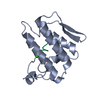
 Components
Components Naja sagittifera (cobra) / References: UniProt: P60045, phospholipase A2
Naja sagittifera (cobra) / References: UniProt: P60045, phospholipase A2 HOMO SAPIENS (human) / References: UniProt: P05067
HOMO SAPIENS (human) / References: UniProt: P05067 X-RAY DIFFRACTION / Number of used crystals: 1
X-RAY DIFFRACTION / Number of used crystals: 1  Sample preparation
Sample preparation ROTATING ANODE / Type: RIGAKU RU300 / Wavelength: 1.5418 Å
ROTATING ANODE / Type: RIGAKU RU300 / Wavelength: 1.5418 Å Processing
Processing MOLECULAR REPLACEMENT
MOLECULAR REPLACEMENT Movie
Movie Controller
Controller




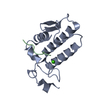
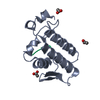

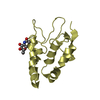
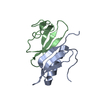

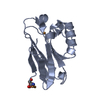
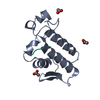
 PDBj
PDBj



















